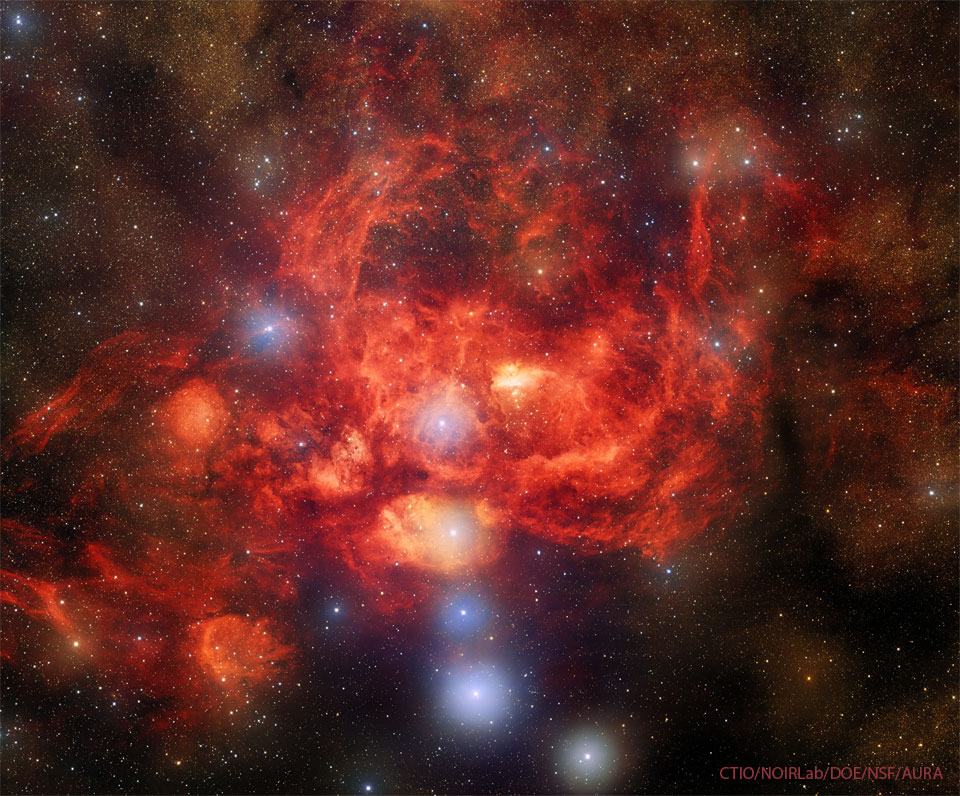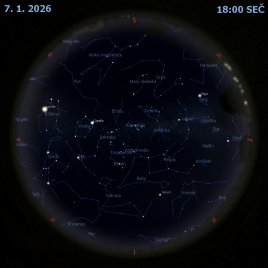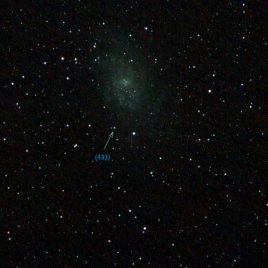NGC 6357: Mlhovina Humr

Uznání: CTIO/NOIRLab/DOE/NSF/AURA; Processing: T. A. Rector (U. Alaska Anchorage/NSF's NOIRLab), J. Miller (Gemini Obs./NSF's NOIRLab), M. Zamani & D. de Martin (NSF's NOIRLab)
Proč v mlhovině Humr vznikají jedny z nejhmotnějších známých hvězd? Nikdo pořádně neví. Mlhovina Humr katalogizovaná jako NGC 6357 hostí blízko svého středu otevřenou hvězdokupu Pismis 24, domov neobvykle jasných a hmotných hvězd. Celková červená záře u vnitřní hvězdotvorné oblasti pochází z emise ionizovaného vodíku. Okolí mlhoviny, které je zde vidět, vykazuje komplexní tapiserii plynu, temného prachu, stále ještě vznikajících hvězd a nově zrozených hvězd. Spletité vzory jsou způsobeny komplexním vzájemným působením mezi mezihvězdnými větry, radiačními tlaky, magnetickými poli a gravitací. Snímek pořídila kamera DECam (Dark Energy Camera) amerického ministerstva energetiky na 4metrovém dalekohledu Blanco na Meziamerické observatoři Cerro Tololo v Chile. NGC 6357 měří asi 400 světelných roků a nachází se asi 8000 světelných roků daleko v souhvězdí Štíra (Scorpion).
Seznam odkazů v popisu
- Harvard.edu: Molecular clouds in the NGC 6334 and NGC 6357 region: Evidence for a 100 pc-scale cloud-cloud collision triggering the Galactic mini-starbursts
- APOD: 2020-08-30 NGC 6357: Katedrála hmotných hvězd
- APOD: 2018-06-12 Star Size Comparison 2
- APOD: Emission Nebulae
- GSU.edu: Ionization Energies
- Wikipedia: Hydrogen
- NOIRLab.edu: Dark Energy Camera Captures Bright, Young Stars Blazing Inside Glowing Nebula
- NOIRLab.edu: Dark Energy Camera Captures Bright, Young Stars Blazing Inside Glowing Nebula
- NOIRLab.edu: Zoomable: Dark Energy Camera Captures Bright, Young Stars Blazing Inside Glowing Nebula
- APOD: 2020-11-22 Tmavé molekulární mračno Barnard 68
- NASA: Stars
- Bark.co: Foto: Pes a toaletní papír :-)
- NASA: Podcast: Dust in the Interstellar wind
- Wikipedia: Radiation_pressure
- Wikipedia: Magnetic_field
- NASA: What Is Gravity?
- NOIRLab.edu: Dark Energy Camera (DECam)
- Energy.gov: Department of Energy
- NOIRLab.edu: Víctor M. Blanco 4-meter Telescope
- Youtu.be: Cerro Tololo Inter-American Observatory - National Optical Astronomy, Chile en 4K
- Wikipedia: Chile
- Harvard.edu: Chandra: Note on Cosmic Distances
- Harvard.edu: Chandra: Scorpius (The Scorpion)
NASA Official: Phillip Newman Specific rights apply. NASA Web Privacy Policy and Important Notices
A service of: ASD at NASA / GSFC & Michigan Tech. U.
Odkaz na originální APOD


